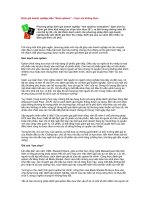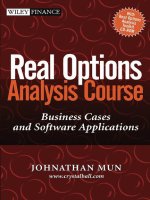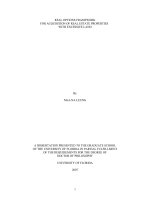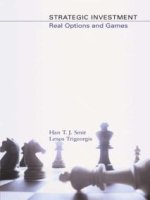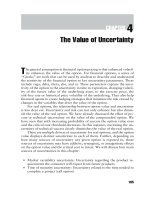FM11 Ch 12 Real Options
Bạn đang xem bản rút gọn của tài liệu. Xem và tải ngay bản đầy đủ của tài liệu tại đây (179.49 KB, 60 trang )
12 - 1
Real options
Decision trees
Application of financial options to
real options
CHAPTER 12
Real Options
12 - 2
What is a real option?
Real options exist when managers can
influence the size and risk of a project’s
cash flows by taking different actions
during the project’s life in response to
changing market conditions.
Alert managers always look for real
options in projects.
Smarter managers try to create real
options.
12 - 3
It does not obligate its owner to
take any action. It merely gives
the owner the right to buy or sell
an asset.
What is the single most important
characteristic of an option?
12 - 4
How are real options different from
financial options?
Financial options have an underlying
asset that is traded usually a
security like a stock.
A real option has an underlying asset
that is not a security for example a
project or a growth opportunity, and
it isn’t traded.
(More )
12 - 5
How are real options different from
financial options?
The payoffs for financial options are
specified in the contract.
Real options are “found” or created
inside of projects. Their payoffs can
be varied.
12 - 6
What are some types of
real options?
Investment timing options
Growth options
Expansion of existing product line
New products
New geographic markets
12 - 7
Types of real options (Continued)
Abandonment options
Contraction
Temporary suspension
Flexibility options
12 - 8
Five Procedures for Valuing
Real Options
1. DCF analysis of expected cash flows,
ignoring the option.
2. Qualitative assessment of the real
option’s value.
3. Decision tree analysis.
4. Standard model for a corresponding
financial option.
5. Financial engineering techniques.
12 - 9
Analysis of a Real Option: Basic Project
Initial cost = $70 million, Cost of
Capital = 10%, risk-free rate = 6%,
cash flows occur for 3 years.
Annual
Demand Probability Cash Flow
High 30% $45
Average 40% $30
Low 30% $15
12 - 10
Approach 1: DCF Analysis
E(CF) =.3($45)+.4($30)+.3($15)
= $30.
PV of expected CFs = ($30/1.1) +
($30/1.1
2
) + ($30/1/1
3
) = $74.61 million.
Expected NPV = $74.61 - $70
= $4.61 million
12 - 11
Investment Timing Option
If we immediately proceed with the
project, its expected NPV is $4.61
million.
However, the project is very risky:
If demand is high, NPV = $41.91
million.*
If demand is low, NPV = -$32.70
million.*
_______________________________________
* See FM11 Ch 12 Mini Case.xls for calculations.
12 - 12
Investment Timing (Continued)
If we wait one year, we will gain
additional information regarding
demand.
If demand is low, we won’t implement
project.
If we wait, the up-front cost and cash
flows will stay the same, except they
will be shifted ahead by a year.
12 - 13
Procedure 2: Qualitative Assessment
The value of any real option increases
if:
the underlying project is very risky
there is a long time before you must
exercise the option
This project is risky and has one year
before we must decide, so the option to
wait is probably valuable.
12 - 14
Procedure 3: Decision Tree Analysis
(Implement only if demand is not low.)
NPV this
$35.70
$1.79
$0.00
Cost
0 Prob. 1 2 3 4
Scenario
a
-$70 $45 $45 $45
30%
$0 40% -$70 $30 $30 $30
30%
$0 $0 $0 $0
Future Cash Flows
Discount the cost of the project at the risk-free rate, since the cost is
known. Discount the operating cash flows at the cost of capital.
Example: $35.70 = -$70/1.06 + $45/1.1
2
+ $45/1.1
3
+ $45/1.1
3
.
See Ch 12 Mini Case.xls for calculations.
12 - 15
E(NPV) = [0.3($35.70)]+[0.4($1.79)]
+ [0.3 ($0)]
E(NPV) = $11.42.
Use these scenarios, with their given
probabilities, to find the project’s
expected NPV if we wait.
12 - 16
Decision Tree with Option to Wait vs.
Original DCF Analysis
Decision tree NPV is higher ($11.42
million vs. $4.61).
In other words, the option to wait is
worth $11.42 million. If we implement
project today, we gain $4.61 million
but lose the option worth $11.42
million.
Therefore, we should wait and decide
next year whether to implement
project, based on demand.
12 - 17
The Option to Wait Changes Risk
The cash flows are less risky under the
option to wait, since we can avoid the
low cash flows. Also, the cost to
implement may not be risk-free.
Given the change in risk, perhaps we
should use different rates to discount
the cash flows.
But finance theory doesn’t tell us how to
estimate the right discount rates, so we
normally do sensitivity analysis using a
range of different rates.
12 - 18
Procedure 4: Use the existing model
of a financial option.
The option to wait resembles a
financial call option we get to “buy”
the project for $70 million in one year
if value of project in one year is
greater than $70 million.
This is like a call option with an
exercise price of $70 million and an
expiration date of one year.
12 - 19
Inputs to Black-Scholes Model for
Option to Wait
X = exercise price = cost to implement
project = $70 million.
r
RF
= risk-free rate = 6%.
t = time to maturity = 1 year.
P = current stock price = Estimated on
following slides.
σ
2
= variance of stock return =
Estimated on following slides.
12 - 20
Estimate of P
For a financial option:
P = current price of stock = PV of all
of stock’s expected future cash flows.
Current price is unaffected by the
exercise cost of the option.
For a real option:
P = PV of all of project’s future
expected cash flows.
P does not include the project’s cost.
12 - 21
Step 1: Find the PV of future CFs at
option’s exercise year.
PV at
0 Prob. 1 2 3 4 Year 1
$45 $45 $45 $111.91
30%
40% $30 $30 $30 $74.61
30%
$15 $15 $15 $37.30
Future Cash Flows
Example: $111.91 = $45/1.1 + $45/1.1
2
+ $45/1.1
3
.
See Ch 12 Mini Case.xls for calculations.
12 - 22
Step 2: Find the expected PV at the
current date, Year 0.
PV
2004
=PV of Exp. PV
2005
= [(0.3* $111.91) +(0.4*$74.61)
+(0.3*$37.3)]/1.1 = $67.82.
See Ch 12 Mini Case.xls for calculations.
PV
Year 0
PV
Year 1
$111.91
High
$67.82 Average $74.61
Low
$37.30
12 - 23
The Input for P in the Black-Scholes
Model
The input for price is the present
value of the project’s expected future
cash flows.
Based on the previous slides,
P = $67.82.
12 - 24
Estimating σ
2
for the Black-Scholes
Model
For a financial option, σ
2
is the
variance of the stock’s rate of return.
For a real option, σ
2
is the variance of
the project’s rate of return.
12 - 25
Three Ways to Estimate σ
2
Judgment.
The direct approach, using the
results from the scenarios.
The indirect approach, using the
expected distribution of the project’s
value.
